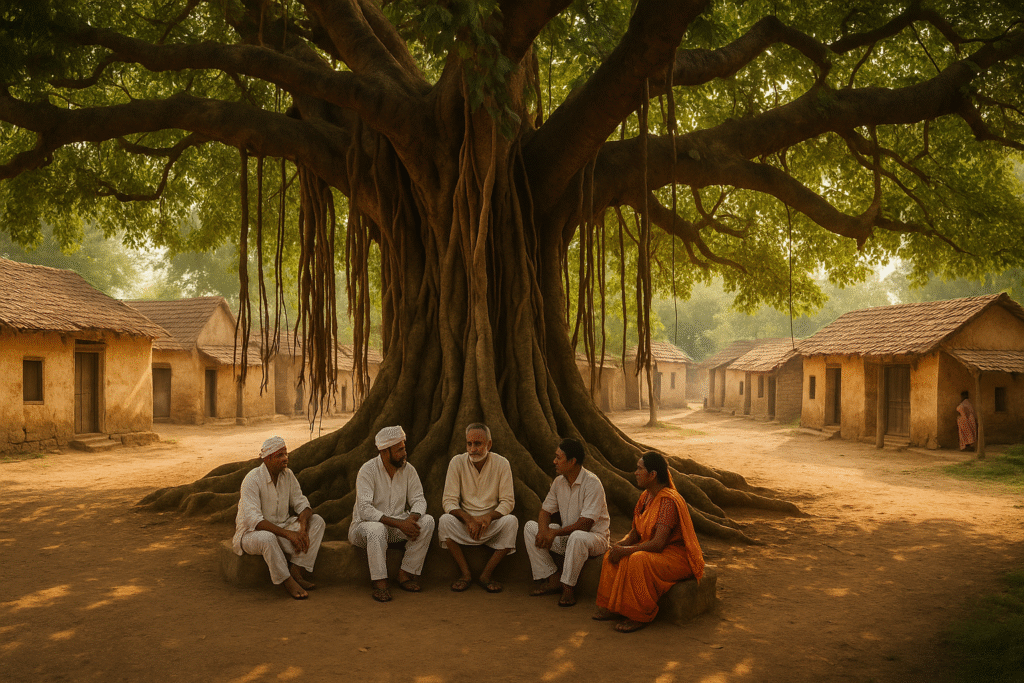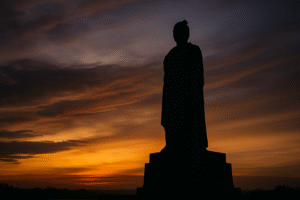Fun fact: The Great Banyan Tree in Kolkata has over 3,600 aerial roots and covers more area than the average football field!
There’s something undeniably magnetic about a banyan tree. Maybe it’s the sheer size, the way its roots grow down like ancient pillars, or the quiet sense of presence it exudes. In India, you’ll find banyan trees not just in forests but in the middle of villages, outside temples, along highways—even in court complexes. We walk past them every day, barely noticing how much they shape our landscape. But here’s a thought: what if our reverence for banyan trees isn’t just cultural, but ecological, emotional—even necessary?
This isn’t just a story about a tree. It’s about how something rooted in the ground has found a place in our stories, our songs, our science—and our souls.
The Tree That Grows Sideways
Unlike most trees that grow taller to reach the sun, the banyan (Ficus benghalensis) grows outward. Its aerial roots drop from branches, anchor into the soil, and become new trunks. It’s a tree that creates its own forest. One banyan tree can become many. No wonder it’s often seen as a symbol of eternity.
The name itself—banyan—comes from “banias,” the merchant class who would trade under the tree’s cool shade. It was more than a resting spot; it was a stock exchange, a tea stall, a village court, and a place of stories. In many parts of India, people still tie sacred threads around its trunk, believing it grants long life and stability in relationships.
But here’s the kicker: what ancient traditions called holy, science now calls genius.
A Micro-Ecosystem in Itself
The banyan isn’t just a tree—it’s an ecosystem.
Each aerial root becomes home to insects, moss, and microbes. Its massive canopy hosts birds, bats, monkeys, and even snakes. Fig wasps (tiny pollinators critical to the banyan’s reproduction) live in a mutual bond with the tree—neither can survive without the other. And the figs? They’re food for dozens of animals, which in turn spread the seeds far and wide.
And let’s not forget the shade. In rural India, where temperatures soar above 45°C in summer, a fully grown banyan can cool the ground underneath by nearly 5°C. It’s a living air conditioner. It captures carbon, stabilizes soil, and prevents erosion. Its roots hold the earth like a tight embrace—exactly what our climate-ravaged soil needs today.
So yes, the banyan is sacred. But not just because our ancestors said so. Because it literally holds life together.
Emotional Infrastructure: Why We Feel Something
Walk under a banyan, and you’ll notice something shift. It’s not just the temperature. It’s the silence. The feeling of being watched—not by eyes, but by time itself. Banyans are slow creatures. They outlive generations. They outlast buildings. When a grandparent says, “I planted that tree,” it often means they planted a memory.
Maybe that’s why so many films, love stories, and folktales are staged under banyans. In Peepli Live, Swades, and dozens of regional films, banyans aren’t background—they’re characters. They become the conscience of a place, bearing witness to birth, betrayal, forgiveness, and farewells.
Our brains register familiarity and safety around large trees. Researchers in environmental psychology call it “biophilic response”—our natural tendency to feel calm around greenery. The banyan, with its cathedral-like spread, hits that nerve.

The “Tree of Life” Is Dying Quietly
Here’s the uncomfortable truth: we are cutting them down.
Urban planners see banyans as inconvenient. Their roots break pavements. Their leaves “clog” drains. Their space is “unusable” for malls, flyovers, or gated societies. So, they get quietly axed—or worse, slowly killed by choking their roots in concrete.
In 2021, Bengaluru lost over 70 mature banyans during a road-widening project. In Hyderabad, authorities chopped down a 150-year-old banyan to make room for a Metro pillar. No pooja was done. No media storm. Just silence. Ironically, these cities are also experiencing rising heat islands, waterlogging, and air pollution—all problems banyans help solve.
This is not nostalgia. It’s science. Cutting down banyans is ecological suicide disguised as progress.
Banyan Trees in Ritual and Resistance
Think about it: why do so many protests, especially in rural India, take place under banyan trees? It’s not just shade. It’s symbolism.
The Chipko Movement—where women hugged trees to stop deforestation—borrowed from this idea. The banyan doesn’t run. It stays. It shelters. It witnesses. When land disputes erupt, people gather under the banyan. When there’s a funeral and no hall, the banyan becomes a temple.
In Maharashtra, a 400-year-old banyan in Bhamburde was saved by local villagers who blocked bulldozers for days. “It’s like losing a grandfather,” said one resident. Emotion, here, wasn’t weakness—it was resistance.
What We Stand to Lose
When we cut a banyan, we don’t just lose a tree. We lose:
- A thousand microclimates
- A natural cooling system
- A seed bank for biodiversity
- A site for collective memory
- A natural community space
- A spiritual anchor
We lose the chance to feel awe.
And let’s face it—moments of genuine awe are becoming rare these days.
Sacred Is Not Superstition
Some will say: “It’s just a tree.” But nothing is ever “just” when it roots itself so deeply in our biology, geography, and psyche.
Our ancestors didn’t need degrees in botany to know what mattered. They built myths, rituals, and taboos around the banyan not because they were foolish—but because they were wise. Sacredness was a strategy. If you protect what you worship, then calling a tree divine was the best conservation law ever invented.
Maybe it’s time we learn from them—not just with data, but with devotion.
Conclusion: Sit Under One. Just Sit.
Go to the nearest banyan tree you know. Don’t take a selfie. Don’t rush. Sit. Feel.
Let the stillness wrap around your senses. Listen to the leaves. Watch the roots. Notice the birds. Smell the earth. You’re not just sitting under a tree. You’re sitting inside a living story.
The banyan doesn’t ask for anything—except that we slow down long enough to remember why it mattered.
And perhaps that’s what sacred really means: something that reminds us of what we forgot.
Author’s Note
I grew up around a massive banyan in my village. It was my hiding spot, my exam prep corner, my heartbreak shelter. Today, it stands on a concrete island between a traffic circle and a petrol pump. Still there. Still waiting. Maybe we should start listening.
G.C., Ecosociosphere contributor.
References and Further Reading
- The Sacred Fig Tree: Ficus benghalensis
- Banyan Tree and Its Role in Urban Biodiversity
- Chipko Movement and Ecofeminism
- https://underthebanyan.blog/2016/09/23/the-majesty-and-mystery-of-indias-sacred-banyan-trees
- https://indianexpress.com/article/india/campaign-by-villagers-saves-400-year-old-banyan-tree-change-in-sangli-highway-plan-6522342




